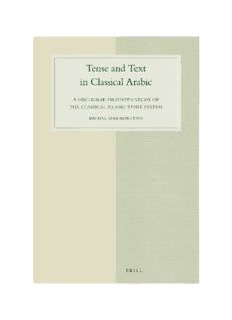
Tense and Text in Classical Arabic: A Discourse-Oriented Study of the Classical Arabic Tense System PDF
Preview Tense and Text in Classical Arabic: A Discourse-Oriented Study of the Classical Arabic Tense System
TenseandTextinClassicalArabic Studies in Semitic Languages and Linguistics EditorialBoard A.D.RubinandC.M.H.Versteegh volume85 Thetitlespublishedinthisseriesarelistedatbrill.com/ssl Tense and Text in Classical Arabic ADiscourse-orientedStudyof theClassicalArabicTenseSystem By MichalMarmorstein leiden | boston This is an open access title distributed under the terms of the Creative Commons Attribution-Noncommercial-NonDerivative3.0Unported(cc-by-nc-nd3.0)License, whichpermitsanynon-commercialuse,anddistribution,providednoalterationsare madeandtheoriginalauthor(s)andsourcearecredited. WantorneedOpenAccess?BrillOpenoffersyouthechoicetomakeyourresearchfreelyaccessibleonline inexchangeforapublicationcharge.Reviewyourvariousoptionsonbrill.com/brill-open. TypefacefortheLatin,Greek,andCyrillicscripts:“Brill”.Seeanddownload:brill.com/brill-typeface. issn0081-8461 isbn978-90-04-30747-6(hardback) isbn978-90-04-31048-3(e-book) Copyright2016byMichalMarmorstein. ThisworkispublishedbyKoninklijkeBrillnv.KoninklijkeBrillnvincorporatestheimprintsBrill,BrillHes &DeGraaf,BrillNijhoff,BrillRodopiandHoteiPublishing. KoninklijkeBrillnvreservestherighttoprotectthepublicationagainstunauthorizeduseandtoauthorize disseminationbymeansofoffprints,legitimatephotocopies,microformeditions,reprints,translations,and secondaryinformationsources,suchasabstractingandindexingservicesincludingdatabases.Requestsfor commercialre-use,useofpartsofthepublication,and/ortranslationsmustbeaddressedtoKoninklijke Brillnv. Thisbookisprintedonacid-freepaperandproducedinasustainablemanner. Contents Acknowledgements ix 1 Introduction 1 1.1 TheProblem 1 1.2 AutonomousorContextualMeaning(s)oftheVerb 4 1.3 TheMethod 8 1.3.1 MethodologicalPrinciples 8 1.3.2 AnOutlineoftheAnalyticalProcedure 11 1.4 LanguageandCorpusDefinition 13 1.4.1 ClassicalArabic 13 1.4.2 ClassicalArabicProse 14 1.5 TheStructureandScopeoftheStudy 18 1.6 TechnicalRemarks 19 2 TheVerbinArabicGrammaticalTradition 20 2.1 TwoFramesofDiscussion 20 2.2 TheSemantologicalFrame 20 2.3 TheGrammaticalFrame 24 2.3.1 ʾiʿrābandbināʾ 24 2.3.2 TheTermal-muḍāriʿ 27 2.4 Summary 32 3 TheVerbinArabisticLiterature 34 3.1 TheVerbalSysteminArabicandSemitic 34 3.2 TheQuestionofTenseorAspect 36 3.3 Summary 39 4 TheStructureofContext 41 4.1 TheConceptualizationofContext 41 4.2 DeicticReference 44 4.3 TextTypes 47 4.4 Interdependency 52 4.5 ClauseTypes 56 4.6 LexicalClasses 58 4.7 Summary 60 vi contents 5 TheVerbalInventory 61 5.1 InventoryofForms 61 5.2 IndicativeVerbalForms 62 5.2.1 SimpleForms 62 5.2.2 ModifiedForms 64 5.2.2.1 TheModifierqad 65 5.2.2.2 TheModifierla- 67 5.2.2.3 TheModifiersawfa/sa- 68 5.2.3 CompoundForms 68 5.3 ModalVerbalForms 71 5.4 NegatedVerbalForms 73 5.5 Summary 75 6 TheSyntagmaticStructureoftheClause 76 6.1 TheInter-clausalSyntagm 76 6.1.2 DependencyStatus 76 6.1.3 LinkingDevices 78 6.2 TheIntra-clausalSyntagm 82 6.2.1 WordOrderandAgreement 82 6.2.2 ClausalOperators 83 6.2.2.1 OperatorsofEmbeddedClauses 84 6.2.2.2 OperatorsofNon-embeddedClauses 86 6.3 Summary 88 7 TheVerbalParadigminEmbeddedClauses 89 7.1 Preliminaries 89 7.2 Substantival(Content)ʾanna-clauses 90 7.3 Adjectival/RelativeClauses 96 7.3.1 llaḏī-clauses 96 7.3.2 AsyndeticAdjectivalClauses 100 7.3.3 mā-clauses 105 7.3.4 man-clauses 111 7.4 Adverbialḥīna-clauses 115 7.5 Summary 117 8 ThePredicativeParadigm 119 8.1 Preliminaries 119 8.2 Verbalcomplexes 121 8.2.1 kāna-compounds 123 8.2.2 ModifyingVerbs 131 contents vii 8.2.3 MotionandStateVerbs 134 8.2.4 PerceptionandPermissionVerbs 140 8.2.5 SpeechVerbs 145 8.3 CircumstantialClauses 145 8.4 MutuallyDependentClauses 151 8.4.1 SettingClauses 152 8.4.2 PresentativeClauses 154 8.5 Summary 155 9 TheVerbalParadigmintheDialogue 158 9.1 Preliminaries 158 9.2 DeclarativeClauses 161 9.2.1 PlainDeclaratives 163 9.2.2 Argumentativeʾinna-clauses 173 9.2.3 Asseverativeʾinnala-clauses 175 9.2.4 NegativeClauses 177 9.3 PerformativeClauses 182 9.4 OptativeClauses 185 9.5 InterrogativeClauses 188 9.6 Summary 192 10 TheVerbalParadigmintheNarrative 194 10.1 Preliminaries 194 10.2 TheMain-line: faʿala-initiatedChains 198 10.2.1 Thefaʿalaconn-faʿalaPattern 198 10.2.2 Thefaʿalayafʿalu/fāʿilanPattern 200 10.2.3 Thefaʿalafa-yafʿaluPattern 202 10.3 TheBackground 208 10.3.1 FreeandDependentClauses 209 10.3.2 EventiveandDescriptiveBackground 211 10.4 Setting-presentativeConstructions 214 10.4.1 SettingandPreposedTemporalClauses 215 10.4.2 PresentativeClauses 217 10.5 GenericNarratives 218 10.6 Summary 220 11 TheVerbalParadigmintheGenericUtterance 221 11.1 Preliminaries 221 11.2 TheStructureofGenericClauses 224 11.3 IndicativeVerbalFormsinGenericClauses 224 viii contents 11.4 ModalVerbalFormsinGenericClauses 232 11.5 Summary 232 12 Conclusions 234 References 241 Index 253 Acknowledgements ThisstudyisanadaptationofmyPh.D.dissertation.Iwouldliketothankthe manyindividualswhohavehelpedmeduringvariousstagesofthiswork. I am grateful to my late mentor, Gideon Goldenberg. I had the rare good fortune of being a student of this great person and scholar. His humanistic approach to language, and life in general, will always be a model for me to pursue.Thisworkisdedicatedtohismemory. NostandardthankscouldexpressmygratitudetoEranCohen,myteacher andmentorfromdayoneattheHebrewUniversity.Iamgratefulforhiscon- stantsupportandguidance,forteachingmethehigheststandardsofscholarly work and instilling in me the confidence to pursue my own path of think- ing. SpecialthanksareduetomyteachersandfriendsfromtheDepartmentof LinguisticsattheHebrewUniversity.Ithank,inparticular,EitanGrossman,for manyinstructiveconversationsonlinguisticissuesandwiseadviceingeneral, andforassistingmeonsomanyoccasions;ArielShisha-Halevy,forteachingme criticallinguisticthinkingandforalwaystakingthetimetodiscusswithmethe mostchallengingquestions;andMosheTaube,forhismostgeneroussupport in the final stages of preparing this work for publication. I am also grateful to my friend Guy Ron-Gilboa, from the Department of Arabic Language and LiteratureattheHebrewUniversity,forcarefullyreadingthisworkandoffering hisinvaluablecomments. MysincerethanksalsogototheDepartmentofLinguisticsatGeorgetown University,whereIwasaVisitingResearcherduringtheacademicyear2012– 2013.Ithank,inparticular,myfriendRuthKramer,whowelcomedmeintothe department,andHeidiHamilton,whohastaughtmetheessenceofdiscourse- orientedwork. Acknowledgements are also due to my colleagues and friends from the DepartmentofSemiticandEgyptianLanguagesandLiteraturesattheCatholic University of America, where I was a Research Fellow during the 2013–2014 academicyear.Iwishtothank,inparticular,EdwardCook,Fr.SidneyGriffith, MonicaBlancherd,andRyannCraig. Igivethanks,too,toRoniHenkin,fromtheHebrewLanguageDepartment atBen-GurionUniverstiy,forsuggestingimportantimprovementstothiswork, andforherencouragementandsupport. I wish to thank the two anonymous reviewers of this work for their com- mentsandsuggestions.ThanksarealsoduetoBrill’seditors,MarjoleinSchaake andMaartenFrieswijk,forbeingexceptionallyresponsiveandhelpful.
Description: